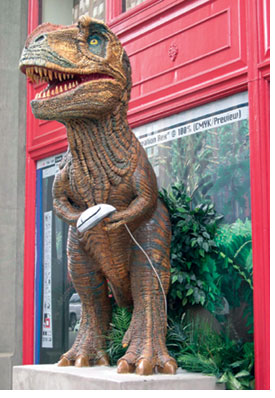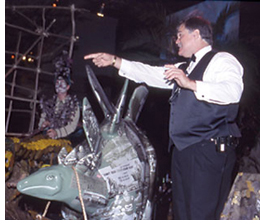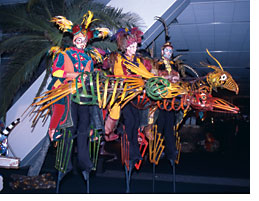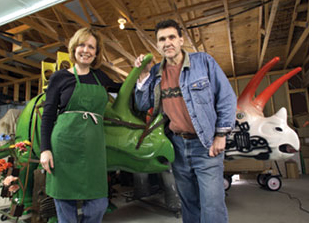By R.J. Gangwere
 It had been 65 million
years since dinosaurs were last seen, en masse, in
Pittsburgh. But in the summer of 2003, they were
everywhere—greeting
visitors at Pittsburgh International Airport, entertaining
lunchtime passersby throughout the streets of downtown
Pittsburgh, and engaging curious shoppers at the city’s
hot new retail complex, The Waterfront, in Homestead. It had been 65 million
years since dinosaurs were last seen, en masse, in
Pittsburgh. But in the summer of 2003, they were
everywhere—greeting
visitors at Pittsburgh International Airport, entertaining
lunchtime passersby throughout the streets of downtown
Pittsburgh, and engaging curious shoppers at the city’s
hot new retail complex, The Waterfront, in Homestead.
DinoMite Days, the
public art event sponsored by Carnegie Museum of
Natural History,
did what it said it would
do, and then some. It celebrated Pittsburgh’s international
reputation for scientific innovation by spotlighting
the Museum of Natural History’s world-class dinosaur
collection. “This project was really the culmination
of a century of celebrating Pittsburgh’s historical
connection to dinosaurs,” says Bill DeWalt,
director of Carnegie Museum of Natural History.
That celebration of dinosaurs began over
a hundred years ago, when Carnegie scientists found
a new species of
dinosaur and named it after their benefactor. Diplodocus
carnegii was the museum’s first dinosaur treasure,
but far from the last. Today the museum boasts the world’s
third largest collection of dinosaur fossils. To showcase
them Carnegie Museum of Natural History announced plans
in 2002 to create the world’s premier dinosaur
exhibits, collectively called DinoMite Days.
The $35 million project will nearly triple the
space of the museum’s current Dinosaur Hall
and, for the first time anywhere, place dinosaurs
in the environments
in which they lived.
The city, the region, and the state see great potential
for the project, which they agree could become
a first-day attraction for Pittsburgh. In November
2002, then-Governor
Mark Schweiker gave the state’s endorsement
for DinoMite Days with a $15 million grant;
and, once in office, Governor Ed Rendell gave his
seal of
approval for the grant as well. Less than a year
later, as the summer of DinoMite Days turned
into fall, a number of private donors followed
suit. In October 2003, Eden
Hall Foundation announced a lead gift of $5 million—a
gift that matches the largest the foundation has ever
given—and The Heinz Foundations announced
a gift of $4 million.
Nearly 100 other donors gave their support as well
by purchasing DinoMite Days dinosaurs. They
bid in-person and online to have the honor of taking
home a piece of
Pittsburgh history.  Sold! Sold!
Nineteen DinoMite Days dinosaurs were pre-purchased,
paid for by “sponsaurs” and benefactors
who knew exactly whom they wanted to support with
their purchase. Alphabetasaurus, paid for by the
Grable Foundation and decorated by school children
at Phillips Elementary School, celebrates the alphabet
as the building block of knowledge, and was donated
to Carnegie Library on the South Side. Ketchupasaurus
was pre-purchased by the H.J. Heinz Corporation,
and with its bright red color and bottle lid snout,
says both “Pittsburgh” and “Heinz” at
the same time. Philiposaurus, pre-purchased by PPG
Industries and named after Philip Johnson, the architect
of PPG Place, is full of glass tiles and mirrors
and is destined to live at PPG Plaza.
 Another 26 dinosaurs were auctioned at the DinoMite Days Gala
and Live Auction. A truly grand black-tie event, the DinoMite Days Gala and Auction attracted some 850 people at
$200 per ticket, and after the auction closed at 10
p.m., another crowd of 350 showed up for dancing and
a dino-party at $40 per ticket. The David L. Lawrence
Convention Center was transformed into a prehistoric
place with props from Hollywood’s Jurassic Park
studios. Stilt-birds and stilt-dinosaurs from Disney
World’s theme parks strode elegantly above the
crowds. “It was one of the most memorable social
events of the year,” says Bill DeWalt, “and
many people—from one-time party-goers to long-time
museum donors—told me it was the best party they
had ever attended in Pittsburgh.” DeWalt credits
event co-chairs Susie Perelman and Heather Austin,
as well as a large team of museum staff and volunteers,
for the event’s success. Another 26 dinosaurs were auctioned at the DinoMite Days Gala
and Live Auction. A truly grand black-tie event, the DinoMite Days Gala and Auction attracted some 850 people at
$200 per ticket, and after the auction closed at 10
p.m., another crowd of 350 showed up for dancing and
a dino-party at $40 per ticket. The David L. Lawrence
Convention Center was transformed into a prehistoric
place with props from Hollywood’s Jurassic Park
studios. Stilt-birds and stilt-dinosaurs from Disney
World’s theme parks strode elegantly above the
crowds. “It was one of the most memorable social
events of the year,” says Bill DeWalt, “and
many people—from one-time party-goers to long-time
museum donors—told me it was the best party they
had ever attended in Pittsburgh.” DeWalt credits
event co-chairs Susie Perelman and Heather Austin,
as well as a large team of museum staff and volunteers,
for the event’s success.
 The next day, another 8,000 people attended DinoMite Days Family Day at the Convention Center. It was the
public’s only chance to view all 100 dinosaurs
in one place. “The crowds were amazing—proof,
once again, that people are wild about dinosaurs,” says
Ted Hermann, director of Marketing for Carnegie Museum
of Natural History and one of the organizers of the
DinoMite Days events. The next day, another 8,000 people attended DinoMite Days Family Day at the Convention Center. It was the
public’s only chance to view all 100 dinosaurs
in one place. “The crowds were amazing—proof,
once again, that people are wild about dinosaurs,” says
Ted Hermann, director of Marketing for Carnegie Museum
of Natural History and one of the organizers of the
DinoMite Days events.
Hermann adds that the museum was equally pleased with
the community’s response to the sale of dinosaurs. “Because
half the proceeds of each dinosaur sale went to the
creation of DinoMite Days and half went
to the charity of the buyer’s choice, it was
a win-win for the entire Pittsburgh community,” Hermann
says.
A final 53 DinoMite Days dinosaurs were sold online
in three lots from October 2 through November 2, 2003.
Online bidders used the website www.dinomitedays.org
to view the dinosaurs and register their bids.
All told, the sale of DinoMite Days dinosaurs raised
$200,000 for DinoMite Days and thousands
more for local charities.
Owning History, Helping the Community
“
I always wanted to go on a dinosaur dig,” says
Dominick Pagniello , an artist and small-business owner
who lives in Mars, Pennsylvania. His everyday passion,
however, is helping special-needs and disadvantaged
children, which he does through Steel Renaissance,
a non-profit group that trains children with special
needs for future careers. He and his wife also own
a cookie store called Cookie Queen where disadvantaged
people learn baking skills
 Pagniello purchased two DinoMite Days dinosaurs online:
The Rise of Fossil Fuels and Renewalsaur, which was
designed by two Carnegie Mellon artists who focused
on the city’s social planning to renew itself. Pagniello purchased two DinoMite Days dinosaurs online:
The Rise of Fossil Fuels and Renewalsaur, which was
designed by two Carnegie Mellon artists who focused
on the city’s social planning to renew itself.
For now, his two dinosaurs sit in his garage. In the
long-term he wants to display Renewalsaur in his expanded
cookie store, and St. Margaret’s Hospital plans
to acquire The Rise of Fossil Fuels from him for public
display. Also, his Cookie Queen store now sells a variety
of custom-made, dinosaur-shaped, sugar-almond cookies.
Like so many people who grew up in the Pittsburgh area,
Pagniello remembers vividly his childhood trips to
the museum to see the dinosaurs. After working for
years in the New York area, he returned to western
Pennsylvania about a decade ago to develop his own
business and, ultimately, to support his community. “I
think we’re all here to make some kind of a difference,” Pagniello
says. “In some small way, I hope I’m doing
that.”
Joseph C. Guyaux, president of The PNC Financial Services
Group Inc., says that his firm immediately recognized
the community benefits of DinoMite Days. “It
was a terrific way to benefit the entire region,” Guyaux
says. “Not only did it help Carnegie Museum of
Natural History, but it also brought attention to the
city and resulted in additional support for charities
throughout western Pennsylvania. That's why PNC bought
nine dinosaurs and found ways for children and teenagers
to decorate some of our dinosaurs and enjoy all of
them.”
The benefits of DinoMite Days were not lost on the
Greater Pittsburgh Convention and Visitors Bureau,
either. According to Tinsy Lipchak, director of Cultural
Tourism for the Greater Pittsburgh Visitors and Convention
Bureau, DinoMite Days was the anchor attraction of
her office’s summer “Kidsburgh” promotion,
which works to bring families from neighboring cities
and states to Pittsburgh during summer vacation: “Visitors
absolutely loved the dinosaurs—many of them following
the map and taking photographs with as many dinosaurs
as they could find.”
The Bureau itself was a co-sponsor, along with Blattner
Brunner Inc., of a dinosaur. The dinosaur was a Torosaurus
called Primal Cuts because it is divided into several
parts. It was displayed during the project in the Faith
Gallo Garden downtown. The theme of Primal Cuts is
that while a study of fragments can lead to understanding,
it can also distract people from seeing the whole object—a
theme appropriate to seeing the greater Pittsburgh
region as a whole, and not judging it by just one of
its parts.
“This was a truly remarkable event that was a win
for the museum, for artists, for other non-profits, for
the city and region, and especially for the thousands
of people to whom the dinosaurs brought smiles and
squeals of delight,” says Bill DeWalt. “We
owe a lot to the Laurel Foundation and the many other
sponsors of this project for making it happen. Many
people have commented to me that this was the most
creative and effective project this city has ever seen.”
Maybe the words of some enthusiastic visitors, sent
in letters to the museum, sum it up best: “My
family and I have been dinosaur hunting for the last
four weekends. We would like to thank you for a wonderful
time.” Another DinoMite Days fan said, simply, “Thank
you for a spectacular summer.”
Back to Contents
|